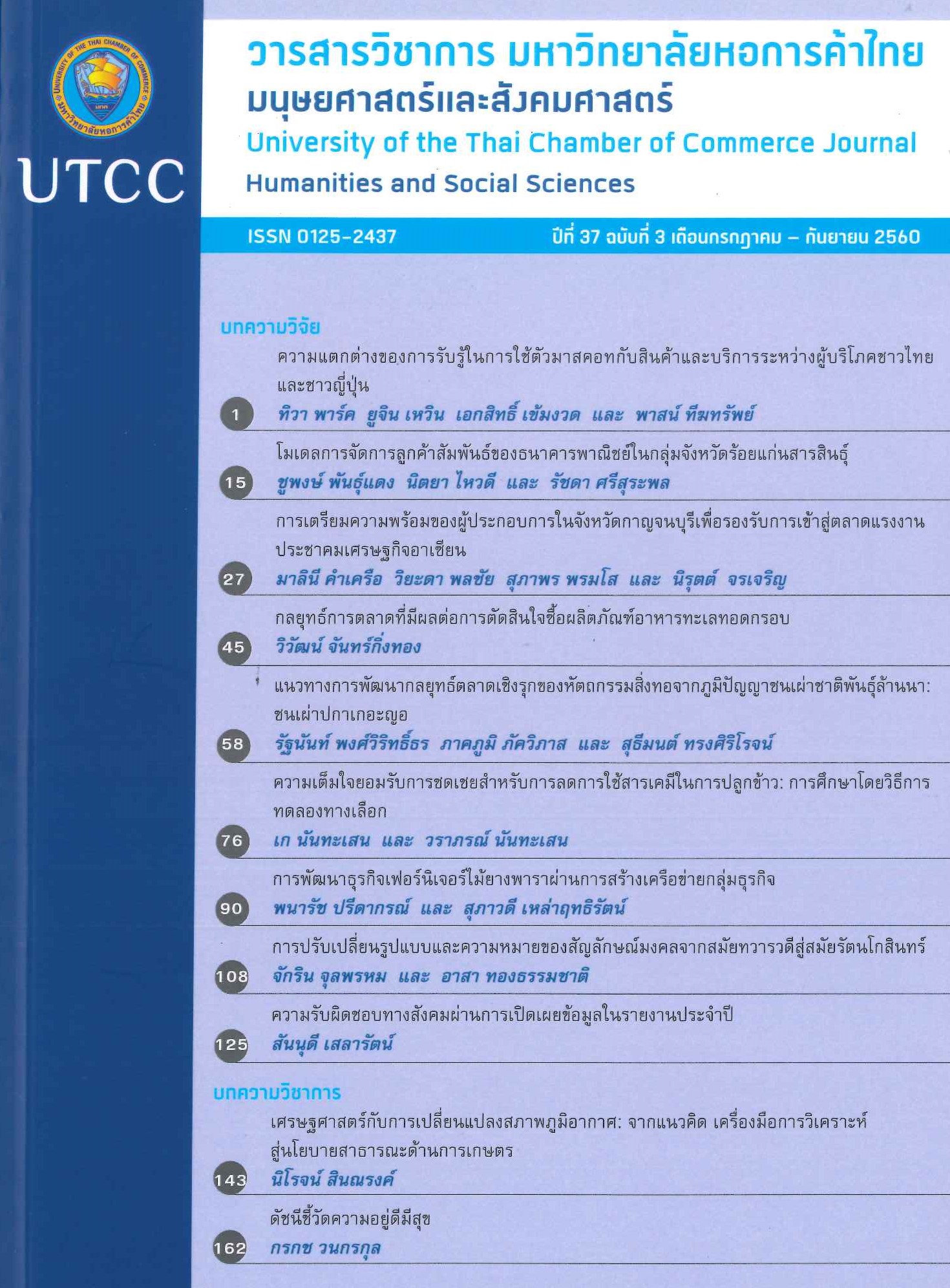การปรับเปลี่ยนรูปแบบและความหมายของสัญลักษณ์มงคลจากสมัยทรารวดีสู่สมัยรัตนโกสินทร์
Main Article Content
บทคัดย่อ
การศึกษานี้เป็นการวิจัยเชิงพรรณา (Descriptive Research) เกี่ยวกับสัญลักษณ์มงคลทั้งในด้านรูปแบบและความหมายของโบราณวัตถุที่พบตั้งแต่สมัยทวารวดีถึงสมัยรัตนโกสินทร์ การเลือกตัวอย่างเป็นแบบเจาะจงศึกษาจากแหล่งข้อมูลประเภทภาพถ่ายนที่ตีพิมพ์เผยแพร่ มีขอบเขตการวิจัยเกี่ยวกับการเปลี่ยนแปลงรูปแบบของสัญลักษณ์และการแปรความหมายของสัญลักษณ์เหล่านั้นที่มีการเปลี่ยนแปลงไปในช่วงเวลาต่าง ๆ สัญลักษณืมงคล คือ เครื่องหมายที่แทนพรหรือสิริมงคล ในดินแดนประเทศไทยปรากฎสัญลักษณ์มงคลบนแผ่นจุณเจิมมาตั้งแต่สมัยทรวารวดี สันนิษฐานว่า ได้รับอิทธิพลจากศิลปะอินเดียเนื่องจากปรากฏเป็นภาพคชลักษณ์มีอันเป็นคติมงคลจากอินเดีย และใช้ในพิธีของศาสนาพราหมณ์ นอกจากนี้ยังพบว่าสัญลักษณ์มงคลแบ่งออกเป็น 2 กลุ่ม คือสัญลักษณ์ที่เกี่ยวกับความอุดมสมบูรณ์ เช้น ดอกบัว ปลา หม้อน้ำ และสัญลักษณ์ที่เกี่ยวข้องกับสถาบันกษัตริย์ เช่น ฉัตร ขอสับช้าง และสังข์ เป็นต้น อย่างไรก็ตาม เมื่อเปรียบเทียบสัญลักษณ์มงคลในสมัยทรารวดีกับปัจจุบัน พบว่า มีรูปแบบและการปรากฏที่แตกต่างกันบ้าง เช่น การเปลี่ยนจากฉัตรชั้นเดียวเป็นฉัตรหลายชั้น หรือสัญลักษณ์ปลาคู่ ซึ่งเคยปรากฏในพระราชพิธีสมัยทวารวดีก็ไม่ปรากฏในพระราชพิธีปัจจุบันแล้ว
Article Details
ลิขสิทธิ์ของบทความ
ผลงานที่ได้รับการตีพิมพ์ถือเป็นลิขสิทธิ์ของมหาวิทยาลัยหอการค้าไทย ห้ามมิให้นำเนื้อหา ทัศนะ หรือข้อคิดเห็นใด ๆ ของผลงานไปทำซ้ำ ดัดแปลง หรือเผยแพร่ ไม่ว่าทั้งหมดหรือบางส่วนโดยไม่ได้รับอนุญาตเป็นลายลักษณ์อักษรจากมหาวิทยาลัยหอการค้าไทยก่อน
เอกสารอ้างอิง
Chiachanpong, P. (2002). Ha Pra Ha Chao: Regalia. Bangkok, Thailand: Matichon. (in Thai).
Fine Arts Department. (2009). Dvaravati’ s art: The origin of Buddhist’ art. Bangkok, Thailand: Amarin Printing and publishing. (in Thai).
Indravut, P. (2005). Dvaravati: The Archaeological evidence analysis study. Bangkok, Thailand: Saksopha printing. (in Thai).
Indravut, P. (2010). “Open the Door to Dvaravati” Lecture at Uthong National Museum.
Krachaechan, P. (2001). The archaeological excavations at Baan Nong Chik: The Stone Crafts. MuangBoran, 27(1), 141-146. (in Thai).
Kruathongkiaw, N. (2010). Detect Luck Sami goddess. Bangkok, Thailand: Museun Press. (in Thai).
Laomanachareon, S. (2007). Chakravartin and arts. In Suchit Wongthet (Ed.). Chakravartin: The supporter of Thai people (p.34-35). Bangkok, Thailand: Bangkok Metropolitan,
Department of Culture Sport and Tourism. (in Thai).
Pinkhanngern, V. (2008). Artistically of Royal packaging. Bangkok, Thailand: Amarin Printing. (in Thai).
Saisingha, S. (2004). Dvaravati’s art: The first Buddhist’s culture in Thailand. Bangkok, Thailand: MuangBoran. (in Thai).
Suksawat, S., M.R. (1994). From Dvaravati to Rattanakosin Period: The King Rama 3 Monument, he should wear his hat. Bangkok, Thailand: MuangBoran. (in Thai).
Yubhodi, D. (1965). Dhammachakkra. Bangkok, Thailand: Fine Arts Department. (in Thai)


